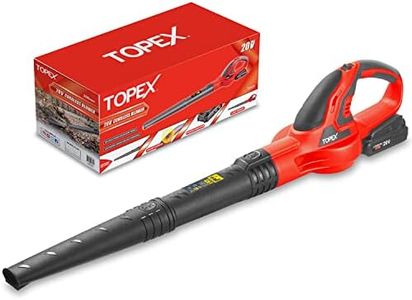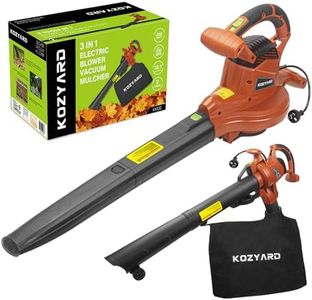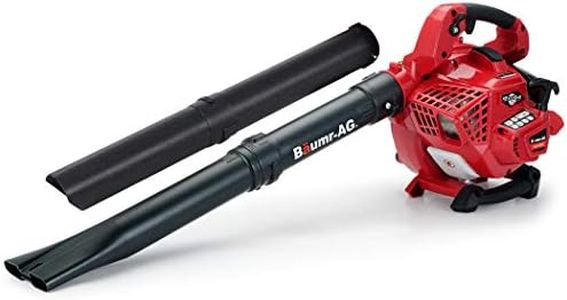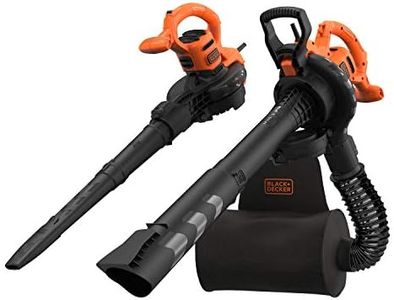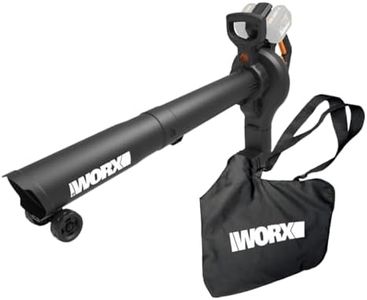We Use CookiesWe use cookies to enhance the security, performance,
functionality and for analytical and promotional activities. By continuing to browse this site you
are agreeing to our privacy policy
8 Best Leaf Vacuum Mulchers
From leading brands and best sellers available on the web.By clicking on a link to a third party's website, log data is shared with that third party.
Buying Guide for the Best Leaf Vacuum Mulchers
Choosing the right leaf vacuum mulcher can make your yard work much easier and more efficient. It's essential to think about how large your outdoor space is, the type of debris you'll be clearing, and how often you'll use the machine. Before buying, try to imagine yourself using it—consider how heavy it might feel, if you need to carry it or wheel it, and whether the mulched leaves will be for simple disposal or for composting.Power SourceThe power source tells you how the leaf vacuum mulcher is powered—typically gas, corded electric, or battery (cordless electric). Gas models tend to be the most powerful and best for large yards, but they are heavier, noisier, and require fuel and engine maintenance. Corded electric models are lighter and quieter, with steady power as long as you're plugged in, but your movement is limited by the cord's length. Battery-powered models offer greater movement freedom and are quieter, but may not run as long or be as powerful as others. Think about how big your yard is and if you'll need to go far from a power outlet to decide which power source is right for you.
Mulching RatioThe mulching ratio tells you how much the vacuum can reduce the volume of leaves. For example, a 16:1 ratio means sixteen bags of leaves are mulched down to the size of one bag. A higher ratio means more efficient shredding and less bagging. If you plan to compost or want to minimize waste, look for a higher mulching ratio. For lighter use or simple clean-up, nearly any ratio will do, but for heavy-duty or repeated use, a better ratio saves effort and time.
Bag CapacityBag capacity indicates how much mulched material the collection bag can hold. Larger bags mean you can work longer without stopping to empty, but they become heavier and bulkier to carry. Small to medium bags work well for small yards or short jobs, while larger bags are useful in bigger areas but may increase the weight you need to haul around. Consider your own strength and how much ground you'll need to cover to find a comfortable balance.
Weight and ErgonomicsWeight and ergonomics refer to how heavy the unit is and how comfortable it feels to use. Heavier models can tire your arms and back, especially if you have a large area or lots of leaves. Some designs include padded handles, harnesses, or wheels, making them easier to manage. If you have limited strength or expect long sessions, choose a lighter, ergonomically designed model, and ideally test it out to check the comfort.
Vacuum and Blower SpeedVacuum and blower speed, measured in miles per hour (MPH) or cubic feet per minute (CFM), shows how forcefully the machine can suck or blow leaves. Higher numbers mean more power to move or collect stubborn, wet, or heavy debris. Lower speeds are fine for dry, light leaves on patios or small lawns. If you’re dealing with large piles, damp leaves, or want faster cleaning, opt for higher speeds, but for delicate garden beds or lighter work, less power is sufficient.
Ease of Switching ModesMany leaf vacuum mulchers also serve as blowers and sometimes as leaf shredders. How easy it is to switch between vacuuming and blowing can greatly improve your experience. Some models require tools and more time to change modes, while others have a single-switch conversion. If you plan on using both functions frequently, look for models that switch modes easily and quickly for more convenience.

